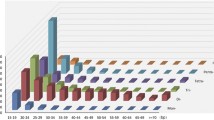Abstract
Microsatellites are powerful markers often isolated de novo for species yet to be investigated. Enriched genomic libraries are usually used for isolation purposes. We critically evaluate the outcome of an enrichment-based protocol applied to two insect species (the ant Lasius austriacus and the beetle Pityogenes chalcographus) which yielded contrasting numbers of suitable loci. Our findings of differences in microsatellite isolation are consistent with the available data on differences in genomic characteristics across these taxa. In the beetle repeated isolation of identical motifs, difficulties in primer development, and multibanded products caused loss of most candidate clones. We identified critical steps during marker development.
Similar content being viewed by others
References
Dieringer D, Schlötterer C (2003) Two distinct modes of microsatellite mutation processes: evidence from the complete genomic sequences of nine species. Genome Res 13:2242–2251
Fagerberg AJ, Fulton RE, Black WC (2001) Microsatellite loci are not abundant in all arthropod genomes: analyses in the hard tick, Ixodes scapularis and the yellow fever mosquito, Aedes aegypti. Insect Mol Biol 10:225–236
Huang S, Weir BS (2001) Estimating the total number of alleles using a sample coverage method. Genetics 159:1365–1373
Lockhart PJ, Steel MA, Hendy MD, Penny D (1994) Recovering evolutionary trees under a more realistic model of sequence evolution. Mol Biol Evol 11:605–612
Meglécz E, Petenian F, Danchin E, Coeur d’Acier A, Rasplus JY, Faure E (2004) High similarity between flanking regions of different microsatellites detected within each of two species of Lepidoptera: Parnassius apollo and Euphydryas aurinia. Mol Ecol 13:1693–1700
Rose O, Falush D (1998) A threshold size for microsatellite expansion. Mol Biol Evol 15:613–615
Ross CL, Dyer KA, Erez T, Miller SJ, Jaenike J, Markow TA (2003) Rapid divergence of microsatellite abundance among species of Drosophila. Mol Biol Evol 20:1143–1157
Sallé A, Kerdelhué C, Breton M, Lieutier F (2003) Characterization of microsatellite loci in the spruce bark beetle Ips typograhus (Coleoptera: Scolytinae). Mol Ecol Notes 3:336–337
Sallé A, Arthofer W, Lieutier F, Stauffer C, Kerdelhué C (2007) Phylogeography of the spruce bark beetle Ips typographus in Europe, as revealed by microsatellites and mitochondrial DNA sequences. Biol J Linn Soc 90:239–246
Thoren PA, Paxton RJ, Estoup A (1995) Unusually high frequency of (CT)n and (GT)n microsatellite loci in a yellowjacket wasp, Vespula rufa (L.) (Hymenoptera: Vespidae). Insect Mol Biol 4:141–148
Zane L, Bargelloni L, Patarnello T (2002) Strategies for microsatellite isolation: a review. Mol Ecol 11:1–16
Zhang DX (2004) Lepidopteran microsatellite DNA: redundant but promising. Trends Ecol Evol 19:507–509
Zhu Y, Strassmann JE, Queller DC (2000) Insertions, substitutions, and the origin of microsatellites. Genet Res 76:227–236
Acknowledgments
We thank A. Stradner, H. Konrad, and K. Moder for valuable assistance, Editor-in-Chief, M. Kreitmann, Associate Editor, J. G. Oakeshott, and two anonymous referees for constructive criticism and the FWF for funding this project.
Author information
Authors and Affiliations
Corresponding author
Additional information
Reviewing Editor: Dr. John Oakeshott
Rights and permissions
About this article
Cite this article
Arthofer, W., Schlick-Steiner, B.C., Steiner, F.M. et al. Lessons from a Beetle and an Ant: Coping with Taxon-Dependent Differences in Microsatellite Development Success. J Mol Evol 65, 304–307 (2007). https://doi.org/10.1007/s00239-007-9012-1
Received:
Accepted:
Published:
Issue Date:
DOI: https://doi.org/10.1007/s00239-007-9012-1




